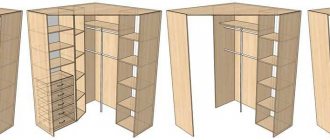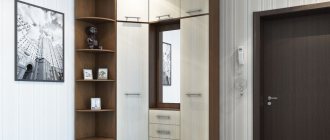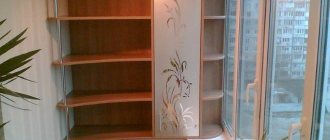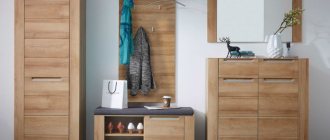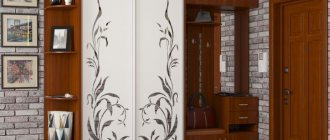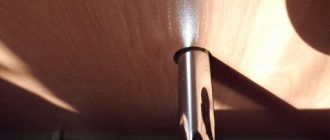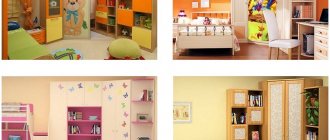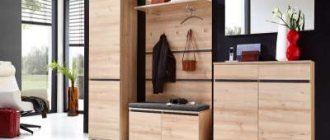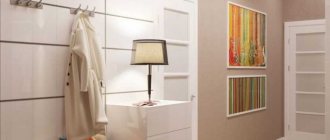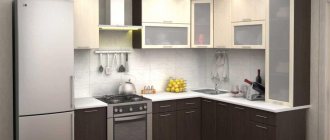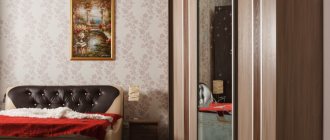Even in a spacious house or apartment you have to think about the rational use of space - every year the number of things increases. What can we say about small-sized apartments? Every centimeter counts here. One way to make optimal use of space is a corner wardrobe. This type of furniture allows you to occupy corners that are rarely used in general - it is difficult to install something there. Next, we’ll talk about what they are and how to plan the “filling” correctly.
Types and features of filling built-in corner cabinets in the hallway
The filling of a corner-type built-in wardrobe—in other words, its internal arrangement—should be carefully considered in advance.
It must be functional, comfortable and maximally adapted to the needs of the home owners.
The standard contents of a hallway closet should include:
- free compartment for outerwear. It can be equipped with regular hooks, a hanger bar or a retractable pantograph hanger. If there are children in the house, then it makes sense to choose a closet with a special second row of hooks located lower;
- top section for hats and scarves;
- lower compartment for shoes - with a shelf or a specialized grid for storing them;
- one or more boxes for storing attributes - gloves, umbrellas, handbags.
It would be great if the closet was equipped with a closed compartment to store things that home owners rarely use.
When selecting the filling, it would be nice to take into account all the little things. Let's say, if you have a separate shoe rack, then the shoe department in the closet can be very small - thanks to this you can make the space larger for other things
Corner cabinets are also usually equipped with optional, but very functional elements:
- open side shelves for storing small items and decorative items;
- key holders in the form of a row of small hooks or a closed box;
- drawers that slide out.
Ideas and models
The functionality of the attic floor is enhanced by built-in furniture. Let's look at some interesting ideas and designs.
Built-in wardrobe with wardrobe compartment
If there is a shortage of space, you can get by with a low cabinet
Interesting arrangement of two door wardrobes in a small room
The withdrawable module allows access to things
How to choose the right one
When choosing furniture for a narrow hallway, you need to take into account many nuances:
material of manufacture - a large number of people pass through the corridor, so the furniture must be durable and reliable. The most ideal material is considered to be natural solid wood; cheaper models are created from MDF or laminated chipboard; style - the shape and design of furniture is chosen in accordance with the overall style of the room. Therefore, it is not recommended to use cabinets with artificially aged surfaces when creating modern interiors; shades - the colors of the facade should not stand out from the overall color scheme of the hallway. For small rooms, light shades are considered optimal, providing a visual expansion of the space; dimensions - dimensions are a decisive factor when choosing a cabinet
Particular attention should be paid to length and depth. The number of necessary pieces of furniture depends on the spaciousness and versatility of the model.
It is quite difficult to choose high-quality furniture that suits all parameters for a small hallway. To do this, you must first determine which pieces of furniture must be in the corridor, and which can be replaced.
It is most convenient to purchase a hallway as a set. The modular system will help make the room stylish and neat. With a competent and rational approach to the choice of furniture, in a narrow hallway you can create an ergonomic living space that can provide all residents of the house with maximum convenience and comfort for many years.
Filling corner cabinets
Like any sliding wardrobe, the corner wardrobe has a certain set of shelves, drawers, baskets and sections for hangers. The peculiarity of the corner cabinet is its shape: there are a number of inconvenient places that, nevertheless, must be used. In some models there are more such inconvenient places (diagonal), in others there are fewer (L-shaped). Proper filling of these inconvenient places is the main task when developing the internal filling of a corner cabinet.
It is necessary to plan the filling in stages
How to fill corners
The difficulty is the use of narrow triangles in diagonal and trapezoidal models. Shelves are usually located here. This is the best option, because there are always small things that can be stored on these shelves.
Shelves are made on the sides of the diagonal corner cabinet
No matter how much you look for options for filling such structures, standard layouts almost always have shelves installed there. There are creative options. For example, a compartment for some long and narrow things - such as umbrellas, skis and ski poles. Or - add hooks or jumpers for storing ties, belts and other similar small items. There are simply no other opportunities to use this type of space.
There is another difficult area that also needs to be carefully considered - the right angle formed by the adjacent walls. Most often there is a compartment for clothes on hangers (hangers, hangers). The most problematic design in this regard is in the form of the letter G. If there is no partition between the two parts, everything is solved simply - a pole is placed in the middle, and crossbars are attached to it.
Internal filling of a corner wardrobe without a partition
If there is a partition, you will have to come to terms with the fact that some part of the space will be inconvenient to use. Typically, out-of-season or rarely worn clothing is sent to this area.
If there is a partition, part of the department will be difficult to access
By filling in the tricky spots, the remaining space can be planned more easily. You just need to decide on the number of different types of things that you plan to place in the closet.
Other content
Inside a wardrobe there are usually three types of filling: shelves, hanger bars and drawers/baskets. Since we have already partially placed the shelves and crossbars, we need to think about whether you need drawers/baskets, and if so, how many and how large they should be. If the furniture is planned for the bedroom, linens are usually stored in drawers, ties, socks, etc. can be stored. In this case, there can be three or more boxes.
If we are talking about a hallway or corridor, then you can only store gloves and some household items in the boxes. One or two boxes are enough here, but you can do without them at all.
An example of filling a five-wall wardrobe
The drawers are not located at the very bottom - so you have to bend or squat to use them. They are placed at hip or waist level. Below and above there are shelves or another compartment for hangers. It all depends on the number of different types of clothes you have.
In corner wardrobes for hallways, the lower part is reserved for storing shoes. In the simplest version, these are shelves with a height of 30 cm for shoes and sandals, and a little more for boots and shoes.
Design features of attic cabinets
An attic closet does not have a specific shape - it follows the contours of the space it occupies. There are many design options, they all depend on the location.
Consider popular places and shapes to help you choose the best position for your furniture:
| Photo | Description |
| Option 1. Sliding wardrobe under the attic slope The top floor in houses with sloping roofs is wider. If the room is not divided into rooms, then the closet is built along the entire wall. The outer door rests on the slope of the roof and takes the appropriate shape. The middle parts of the facade do not differ from the standards - they are rectangular. | |
| Option 2. Sliding wardrobe in the attic slope The functionality of the design does not differ from classic compartment versions. The doors have the usual outlines. The inner part forms a trapezoidal or triangular shape. | |
| Option 3. Sliding wardrobe in both slopes of the attic To make full use of a narrow attic, the closet is made from slope to slope. The central part of the facade remains standard, the outer doors have been modified. All doors open towards the middle. | |
| Option 4. Straight attic cabinet with modules The optimal solution using modules allows you to install a purchased cabinet in the center of the wall. The beveled corner is filled with modules:
|
Sliding doors with bevel
Layout of mechanisms for beveled facades
There are two options for installing compartment doors:
- A fully beveled door ends at a sharp angle. It is not possible to use a suspension system here. The door leaf is installed on the bottom rail, the second part of the mechanism is located in the middle.
- Half/partial chamfered top, has top rail and moving roller, mounts like a regular coupe.
Structure and types
Any cabinets can be used indoors under the roof. It all depends on your preferences and the characteristics of the attic. Let's consider the best options that allow you to rationally use space, with minimal costs for furniture.
| Photo | Description |
| Sloped wardrobe with sliding doors Must have at least 4 doors. This is due to the opening system. The outer door panels have a non-standard fastening and require support when open. The shift runs along a full-fledged rail on which the middle standard sash is installed. | |
| Accordion wardrobe Indispensable for a narrow room. The sashes, fastened with hinges, are small in size and move along lower guides. | |
| Hinged wardrobes They may have partially or completely beveled doors. In some cases, combined models with a sliding system are used. |
Materials
There are no restrictions on the choice of materials. All traditional materials are suitable for attic cabinets:
- MDF and chipboard have an affordable price and pleasant appearance.
- The mirror opens up the perspective of the room and enhances the lighting. For facades, a particularly durable mirror with a protective film is made.
- Matte, glossy, textured, patterned glass is suitable for stylish interiors.
- Plastic is a practical option that requires minimal effort to maintain an aesthetic appearance.
- Leather is exclusive, expensive, exquisite.
- PVC film - a huge selection of colors and textures, budget prices.
There are no restrictions on the choice of materials - you can use any!
Color solutions
The design of the furniture depends on the degree of illumination and the orientation of the windows. For example, the south side always gives more light.
A dark-colored wardrobe in a room with small windows facing north will make the attic look like a gloomy attic. Here it is appropriate to use a furniture façade in pastel or bright colors.
In a bright room, you can install a bright wardrobe, but at the same time equip the windows with thick Roman blinds or blinds. This will help balance the daylight with the colors of the furniture.
In interior design, according to the rules, three colors are used. Each can have the same number of shades. By following this recommendation, you will get a cozy, charming attic.
The choice of cabinet color is made taking into account the ceiling height, size/number of windows, daylight intake, wall decoration, quality of textiles and lighting.
A large drawing on a white background makes the room appear larger
Advantages and disadvantages
Corner structures are often used in hallways, and this is no coincidence. The advantages of such cabinets are difficult to overestimate:
- Increasing the functionality of the room. These types of cabinets make use of corner space that is usually left untapped. This allows you to seriously save useful space. This plus is especially relevant for small corridors.
- Compactness. The hallway is a place that greets and sees off owners and guests every day. Therefore, this area should be cozy, comfortable and as spacious as possible. Corner cabinets take up little space, they do not interfere with freedom of movement, and they look neat. At the same time, they accommodate a large number of things, not inferior to traditional options.
- Style. Modern manufacturers offer corner cabinets to suit every taste. These are both elegant classics and modern original models. A variety of colors, textures, finishes and designs allows you to choose an option that can decorate any hallway. The unusual shape does not at all spoil the appearance of the products, but, on the contrary, becomes a highlight that emphasizes the impeccable taste of the owners.
There are few disadvantages to such furniture. The main thing is not always correct and functional internal content. The contents of such cabinets often consist of classic elements. Shelves of non-standard shapes are rarely used.
Features and Benefits
An ordinary cabinet installed in sloping ceilings and walls will not be able to fully utilize the room. The attic closet has non-standard shapes; Sloping doors or tilted back of the cabinet.
Unlike conventional cabinets, it has a lot of advantages:
- The compartment façade saves space.
- Thanks to its shape, it allows you to use the entire area up to the ceiling.
- Following the contour of the wall, the cabinet rationally uses the sloping corner of the attic and uses “dead zones”.
- Softens interior imperfections.
- Makes it possible to simulate internal filling.
The non-standard shape of the cabinet allows you to use the entire space
Structure, types, sizes
The corner wardrobe can be built-in or cabinet. In built-in ones, room structures are used as walls, floors and ceilings. A façade with sliding doors is attached to them. That is, this design turns out to be stationary - the guides are attached to the walls, floor and ceiling. The advantage of this type of corner cabinets is its cost-effectiveness, the disadvantage is the impossibility of portability. Another important point: the walls, floor and ceiling must be level, otherwise the structure will be skewed, which will negatively affect the operation of the sliding doors.
The cabinet corner wardrobe has its own walls, floor and ceiling
Cabinet corner wardrobes are full-fledged furniture with walls, floor and ceiling. They differ from a regular wardrobe in the presence of sliding doors and in the fact that in height they usually occupy the entire space up to the ceiling. They are delivered from the factory or workshop disassembled and assembled locally, as they have such dimensions that they simply will not fit through the doors.
Types by structure
The shape of corner wardrobes can be of several types:
- L-shaped. The closet occupies two adjacent walls and the corner between them.
- Diagonal. In cross section they have the shape of a triangle. Convenient in small spaces, allowing you to use the space between two doors or windows on adjacent walls.
- Trapezoidal. They have a slightly larger area than diagonal ones.
- Five-walled. The most massive option.
To make the difference in structure more clear, it is better to look at all models in a graphical representation (pictured below).
Types of corner wardrobes
If we talk about ease of use, then the best option is L-shaped. Normally, you can assemble the contents in a five-wall and trapezoidal wardrobe. The most inconvenient, of course, is the triangular one. It will have triangular shelves on both sides, which are not very spacious. At the same time, the middle will be empty, since the filling of the cabinet is located along the walls. The same can be said about the five-walled room, with the only difference being that there are no triangular shelves here.
What material
Any of the designs can be made with elements of radial technology - with rounded corners. Such sliding wardrobes are made from MDF, the manufacturing technology of which allows the production of rounded shapes. MDF is also laminated and there are no fewer color options.
Corner L-shaped wardrobe with radial elements
As you can see in the photo, near the entrance and in the middle part the corners are not sharp, but rounded. Firstly, it looks beautiful, and secondly, it is safer - there are no sharp edges on which you can seriously hurt yourself.
Dimensions
The easiest way is usually to decide on the height - right up to the ceiling or a couple of centimeters lower. All other parameters depend on the room in which you plan to install a corner wardrobe and the available space. We can probably say about the minimum sizes:
- If the cabinet is diagonal with a triangular cross-section, then the minimum length of the sides at the right angle is 120 cm. The volume will be very small, although they can also make walls with a length of 100 cm or even less.
- If one of the walls is longer (120 cm and 80 cm, for example), it is worth considering the option of a trapezoidal section. On the side that is longer, a partition is placed, the depth of which is about 40-45 cm, and a straight line is drawn from it to the short side.
- If the walls adjacent to the corner are short, an L-shaped structure can be installed. Moreover, one of them is desirable to be at least 120 cm, and the second can be shorter.
- Five-wall sliding wardrobes can be installed against walls with a length of 80 cm or more. That is, it can be placed even in the smallest corridor. But due to its great depth, it will “eat up” a lot of space, making the room even smaller.
In a small room, the best choice is an L-shaped design. It is the least massive and leaves more space free. To visually assess this, draw all suitable types of cabinets on the floor plan. Then you can calculate the remaining free space.
A few words about the depth of wardrobes. There are two standard options - 45 cm and 60 cm, the minimum depth is 40 cm. With a width of 60 cm or more, a regular crossbar or pantograph is installed under clothes on hangers in the closet (so that the entire height to the ceiling can be used). Smaller models require a special rod that allows you to place hangers parallel to the door, since the hangers have a standard width of 55 cm and simply do not fit.
Facade selection
The appearance of the corner wardrobe depends on how the doors are designed. They are the ones who attract attention. They are made from:
- MDF and chipboard. Durable and relatively inexpensive materials. They have a lot of colors and textures: imitation of wood of different species and colors, colored smooth-painted surfaces with shine (glossy) or without (matte), designs and ornaments of different styles and types. Corner wardrobe with MDF facade
- Glass (usually frosted, patterned, colored). The glass used is thick, tempered. Some companies offer to apply some kind of design on glass. Usually there is a certain catalog from which you can choose the image you like. With glass doors, even a massive structure does not look so heavy
- Mirrors with possible application of drawings and ornaments using sandblasting. Mirrors are also used thick. They can also have different shades - gray, blue, yellowish, etc. shade. Drawings on the mirror are also usually made from catalogues, but some companies can realize your idea. Mirrors are almost a classic of the genre
- Photo printing is one of the possible coatings for chipboard doors, but due to its unique appearance it is usually placed in a separate category. A drawing or photograph is transferred to the film. The print quality is very high, the image is very realistic.
This piece of furniture cannot be called inconspicuous - Combinations of the materials and technologies described above. The most decorative effect is obtained by combining several materials. The number of combinations is very large and you can choose a front for a corner wardrobe to suit any interior and taste. Combinations often look more interesting
- Radial corner wardrobes. This is the name given to those models whose walls or facades are not straight, but curved. Such models look more modern, smooth lines Curved smooth lines look much better than broken or straight lines
With all this diversity, it is necessary to remember the influence of color on the perception of furniture. Since a corner wardrobe usually occupies a fairly large area, it largely determines the “sound” of the entire interior. Therefore, it is necessary to remember several truths. There aren't that many of them. First, mirrors push boundaries, expanding space. Light semi-gloss or glossy furniture and facades with light glass work approximately the same way. Secondly, dark furniture makes a small room even smaller. If you at least take this into account, there will be fewer questions.
Types of structures
According to the type of design, a corner wardrobe can be:
- Hull;
- Built-in.
The advantage of a free-standing model is that it can be moved, which means there will be no problems if you move.
Built-in wardrobe in the hallway.
For a built-in design, the shelves are attached to the sides of the cabinet and the wall of the room. Then the doors are hung. The advantage of such a system is its versatility and space saving. The disadvantage is the impossibility of installation in another room.
Built-in shelf design.
The wardrobe can have different shapes. There are the following types of structures:
- L-shaped;
- Trapezoidal;
- Diagonal;
- Radial.
The sliding wardrobe, consisting of two modules adjacent to each other, has the shape of the letter “L” in plan. One of the parts, the wider one, is usually intended for outerwear and has a bar that occupies the corner. The short module is equipped with shelves.
The sliding wardrobe, consisting of two modules adjacent to each other, has the shape of the letter “L” in plan.
The diagonal-shaped cabinet has great depth on one side. This model is suitable for small rooms where a standard width design would take up a critical amount of space. Decorated with a mirror, such a system will increase the space, and the diagonal orientation will give the room dynamics.
A system decorated with a mirror will increase the space
Corner radius cabinet is an unusual design solution. The door guides are arranged in an arc. This design has all the advantages of other models and is the highlight of the interior. The absence of corners looks attractive.
Corner radius cabinet is an unusual design solution.
The shape of radius systems can be:
- Concave;
- Convex;
- Wavy;
- Asymmetrical.
The asymmetrical design consists of parts of different depths.
By combining radius and straight modules, combined storage systems are created.
Convex wardrobe design.
Dimensions and installation
The variety of house designs makes it impossible to buy a ready-made, suitable-sized attic closet. The owner has two options: order from a master or make the furniture with his own hands. Let's consider the second option.
Measure the selected wall, make a drawing, calculate the materials. You will need parts for the body and base (laminated chipboard with a thickness of at least 19 mm), rear walls (3.2 mm).
Ceiling, wall, baseboards, plinth cladding, doors. You also need to buy fittings, screws, edge tape, glue.
Internal contents include shelf holders, brackets, drawers, shelves
Assembly
The frame is built on site, according to the existing dimensions. The main parts can be fixed to the walls of the room. In long bars, grooves are selected for the overlapping parts. All end cuts are covered with edge tape.
The front panel is installed on the plinth strictly vertically and fixed to the supporting structure. The sections are assembled separately and attached to clamps through the side walls. Corner strips are mounted in the form of a ceiling or side plinth. So that the screws are not visible, they are driven in from the inside.
There should be gaps between the walls of the room and the closet. This is necessary for natural air circulation
Dimensions
The parameters of the cabinet depend entirely on the height of the ceiling in the ridge, the angle of the slope and the width of the room. The attic wardrobe can have a height starting from 60 cm.
The model with two beveled doors has at least 4 doors, so it cannot be made small. The minimum length is 160 cm, while the width of the door leaves is 40 cm. A cabinet with one bevel - from 120 cm.
The optimal size of a sliding wardrobe with beveled doors is 350 cm
Depth of wardrobes
Any models can be built in the attic. The bevel of the roof makes adjustments to the dimensions, but the widest part is not made less than 40 cm. The most convenient depth is 60 cm.
The cabinet, which rests against the bevel at the back, has an increase/expansion in the lower part; near the floor it can reach up to a meter. A depth of more than 70 cm is considered inconvenient; it is difficult to reach the back wall with your hand. Retractable baskets/drawers and sections on wheels help eliminate this problem.
The optimal cabinet depth is 60 cm
Facade of a built-in corner wardrobe in the hallway: shapes, materials, decor
The facade of the cabinet is its front part, which also includes the decorative design of the doors.
The shape of the facades of built-in corner cabinets can be straight, radius or asymmetrical.
The straight facade has the shape of a rectangle. It fits perfectly into almost any interior design. As a rule, in this case the corner cabinet has the shape of the letter “L”.
The design with a radius facade is made in the form of a semicircle or oval. There are three types of radius facades:
- with an outer radius - that is, convex. This option is ideal for masking external corners;
- with an internal radius - concave design. This is not the most practical product, especially if the radius is large;
- with a variable radius - in the form of a wave. An original solution for spacious hallways. In this case, one part of the product has an internal radius, the other - an external one.
Typically, the following materials are used for the production of facades:
- Chipboard is the most budget option. Its main advantage is the variety of color options. You can even choose chipboard with a very realistic “wood” texture. The disadvantages of this material include poor performance;
- MDF is a more expensive and reliable material. For the manufacture of facades, MDF with a glossy surface is most often used. It also allows you to make curved structures;
- plastic is a lightweight, environmentally friendly and low-maintenance material.
The facade is responsible for the external attractiveness of the entire structure. For their decoration you can use:
- mirrors are the best decor for cramped and narrow corridors. In addition, they also perform a practical function: they can be used to evaluate your appearance when leaving the house;
- glass is one of the most versatile finishing options. It can be used as inserts or overlays over doors. Frosted glass looks impressive - it allows you to expand the space;
- photo printing - applying any images to the cabinet facade using UV printing and laser engraving.
To create a luxurious and rich interior, the facade decoration uses natural wood or leather.
How to choose
When guests enter the hallway, they should immediately understand the style in which your home is decorated. Furniture should fit harmoniously into the decor, continuing the overall concept, and the closet is no exception.
Corner models in a classic style are usually made from solid wood. Variations made from MDF are also allowed, but always with a wood texture. Classics are characterized by elegance and solidity, regular geometric shapes.
The structure of such products usually includes closed compartments with hinged doors and drawers. There is a carriage upholstered stand with open hangers and built-in poufs. Moldings, curly handles, and occasionally carved ornaments and gilding can be used as decorations. The color scheme is predominantly dark (dark and light brown, sometimes beige).
The Provence style is also characterized by wooden furniture with hinged doors. Light shades (white, gray, beige) and metal fittings of simple shapes predominate here. There is practically no decor. The design of the products can be assessed as simplicity with a slight touch of French romance.
Art Nouveau style implies asymmetry and originality. Combinations of round and geometrically straight shapes, combinations of different colors, and uneven block heights are acceptable here. Doors can be either hinged or sliding. Silk-screen printing, photo printing and other methods of furniture decoration are actively used.
Minimalism is characterized by laconicism and restraint. Chromed metal fittings of a strict design, the absence of drawings and other decor - these are the distinctive features of such models. Only a combination of contrasting shades (usually black and white) and mirror elements are allowed. Glossy surfaces are often used. Curved fronts of radius cabinets can fit into both modern styles. It all depends on the choice of design nuances.
For small corridors it is better to choose light furniture. This way you can visually expand the space. The same choice should be made if the walls and floor of the hallway are decorated in dark colors. A cabinet of any color would look appropriate in a spacious and bright room. Although against the background of light walls, dark options stand out especially impressively.
When thinking about the size of your future closet, focus on two main points. Assess the space that you can allocate for furniture and think about what things and how many you are going to store in it.
Its internal content also depends on what will be placed in the closet. Think about whether you need shelves for light clothing or whether it is better to allocate more space for a hanger bar, whether you will need drawers, whether you need open shelves, etc.
Interesting solutions in interior design
A wardrobe with beveled doors can be built under the stairs leading to the attic floor. If all doors have a bevel, then only a swing system is suitable.
Under-stairs cabinet with end shelves
It is not necessary to build a monolithic model under the roof slope. The wall can be divided into parts and visually enlarge the room. Place a desk or computer desk between the cabinets. You can set aside this space for a mirror with a dressing table.
Separating cabinets with a table eliminates “furniture heaviness”
Mirrored facades fill with light and “move apart” the walls. The mirror can cover all doors or just one. Combined options work well, where mirror inserts occupy half or a third of the facade.
Mirror effect doubles the area
A small room needs light furniture. A cabinet located along the entire pediment will not “eat up” the room, but will expand it.
For attic rooms with a small window, choose white furniture
A beveled closet zones the space
Spectacular white bedroom
Advantages and disadvantages
The design of the corner cabinet allows you to use space in the hallway that is difficult to fill with ordinary furniture without it cluttering up the space. There are both advantages and disadvantages of choosing a corner cabinet in the hallway over a regular one.
| Advantages | Flaws |
| Suitable for hallways of any size and shape. Particularly useful is placing a corner cabinet in a small, narrow corridor, in which a regular cabinet either will not fit or will be very small and of little functionality. | Can only be equipped with standard filling elements. You can equip a small wardrobe with curved shelves or drawers, but if the corner module is large, it will not be convenient to use them. |
| It is not inferior in capacity to a regular cabinet, and depending on the specific type, it even surpasses it. | The radius type of wardrobe is not suitable for a small hallway. |
| Saves space | Higher cost compared to conventional, linear wardrobes. |
| Able to correct poor planning | A corner hallway with a wardrobe can be made with your own hands, but it will not be easy. |
| The convenience of using a corner hallway, which consists of free access to the contents of the wardrobe from both sides. | |
| Suitable for use in any interior. | |
| Multifunctionality: a corner closet for a small hallway can store not only clothes, but also shoes and some household items. In comparison, an ordinary wardrobe does not contain a shoe rack. In addition, a corner cabinet often also performs a decorative function thanks to the shelves located on the outside of the cabinet. | |
| A mirrored wardrobe visually increases the space more than a regular compartment with a mirror on the door. This is explained by the fact that a linear wardrobe “pushes” the walls, while a corner wardrobe expands the space diagonally. |
The most important advantage that a corner cabinet for a hallway has, photos of the varieties of which are presented below, is that it can replace all the furniture needed to be placed in the hall. In addition, it has an attractive appearance: a wardrobe placed in the corner of the room will never look bulky.
Photo of design ideas and interior layout
Each corner wardrobe is an individual design. This type of furniture is good because it allows you to adapt to the lifestyle and taste of everyone. But sometimes you need an idea for inspiration, and the easiest way to find it is in a photo of finished furniture.
The design of a corner wardrobe can be in any style. A corner wardrobe in the bedroom is a great way to hide everything unnecessary
Light neutral tones make the interior lighter A mirrored closet door instead of a full-length mirror Another option for filling a five-wall wardrobe A corner wardrobe in a hallway is often complemented with a hanger and a small shelf for shoes
Radial sliding wardrobes can have either convex or concave edges
Smooth lines resemble waves Mirrors make the room visually wider
This is no longer quite a corner wardrobe. More like a small dressing room Combined facades are most often made with mirrors
White gloss and mirror. This solid-sized cabinet does not look bulky at all. One of the options for L-shaped cabinets
Modern hallway corner furniture
An entrance hall with corner furniture has received wide demand. This is due to the peculiarity of combining many functions, ease of assembly, which can be done with your own hands, and a variety of design types. The high functionality of the corner hallway cannot be underestimated; in addition to the closet, there are always various shelves on which you can conveniently arrange various items. The corner furniture includes all the necessary items: hangers, mirrors, hat shelves, umbrella holders, seating and a shoe rack.
Corner furniture is installed in the corner of the room and can have several options:
- In the form of a corner cabinet with additional elements on one or both sides;
- The cabinet is connected on the same level with various bookcases and shelves arranged at right angles with each other.
Choosing a corner hallway implies its further assembly. If the furniture is expensive, then it is better to entrust this process to professionals. If you wish, of course, you can complete the assembly yourself, using drawings and instructions that contain a description of all stages.
Advantages and disadvantages
The choice of a specific model of a corner wardrobe for a hallway is determined by various factors, each of which affects the ergonomics and aesthetics of the room. This piece of furniture has enough advantages:
- spaciousness - the design features of the corner cabinet provide a large internal space with modest external dimensions. This is achieved due to the ability to fully use the niche adjacent to the corner, occupying it with rods for hanging clothes and free space below, where you can hide sports equipment, shoes, and large household appliances (for example, a vacuum cleaner) that are not used before the onset of the season;
- compactness - saving space in the hallway is the main task that a corner wardrobe helps solve. There is no need to calculate the swing of a swing door, which, when open, can interfere with free passage. Placement in the corner of the room complies with the principles of ergonomics: the hallway is not cluttered with randomly placed and hung shoes and outerwear, everything you need can be conveniently folded and taken from the closet;
- versatility - installing a corner wardrobe eliminates the need for home owners to add shelves for shoes, clothes hangers, and a mirror to the hallway. All this can replace a piece of furniture with mirrored doors, open side and closed internal shelves, rods for hanging jackets, coats, fur coats;
- aesthetics - most popular furniture manufacturers offer a wide range of models designed for the hallway. Just look at the numerous photos, the design of corner wardrobes is simply limitless. They can be made of different materials, in different colors, with a variety of decorative elements, which will allow you to choose the option for the hallway that will best suit the planned interior in terms of style and financial capabilities of the apartment owners.
Along with the advantages, this piece of furniture has some disadvantages:
- the impossibility of rearranging the furniture - corner furniture, and especially the built-in wardrobe will not be able to be placed in the hallway in any other way over time. To update the interior of the room, you will either need to replace the cabinet with a different model, or even abandon this piece of furniture to use other design solutions;
- constant care of components - if you do not keep the rail for moving the doors clean and in good condition, quite soon it will be problematic to use the cabinet. The accumulation of dust and dirt in the corners and untimely lubrication of mechanisms will prevent the doors from moving smoothly and closing completely.
How to fill corners
Built-in furniture helps save every centimeter
In addition to sliding wardrobes with beveled doors, the corner space can be filled with built-in cabinets, equipped with closed niches or open shelves.
Often a low cabinet or chest of drawers 80–120 cm is purchased, and a shelving unit is added above it or shelves are made. This economical option allows you to use the entire space.
Low corner areas under the attic windows are considered “dead”. If there is 60 cm or more under the window, build a frame there for compartment or hinged doors. In such a closed corner you can keep any items, including a vacuum cleaner and other equipment.
Filling
The storage system is planned based on what exactly needs to be placed and in what quantity. Outerwear, hats, and outdoor shoes are stored in the hallway. The design is equipped with a system of open shelves, cabinets, clothes rails and drawers of varying depths.
Option for a corner cabinet in the hallway.
For rarely used or seasonal items, for example, a snowboard or sled, you can allocate a separate section in a corner that is difficult to access and hidden from guests. The upper shelves are allocated for suitcases. For small things that should be at hand, it is necessary to provide a separate drawer or shelf.
Compartments for outerwear
It is convenient to store clothes on hangers hung on a bar. If the height of the cabinet is large, you can use telescopic lifting mechanisms.
It is convenient to store clothes on hangers hung on a bar.
Shoe storage
Several shelves should be allocated for shoes. They can be regular or retractable, straight or angled. Modern storage systems allow you to conveniently place shoes in low baskets that allow access to air and allow you to see the contents.
Wardrobe with compartments for shoes.
Shelves and drawers
In addition to the main shelves and drawers for clothes, corner systems can be supplemented with:
- Open shelves with rounded edges for small items and decor;
- A separate system of children's shelves and a hanger at a convenient height;
- Drawers for storing gloves and other accessories;
- Key keeper;
- Shoe shelves - straight or at an angle;
- Place for storing hats;
- Shelves for bags and suitcases.
Convenient arrangement of things
To properly arrange your partitions, you first need to visualize how much space will be used. To do this, first draw a diagram of the shelves.
The length is usually about 60 centimeters. It can be a little shorter if the shelves are located in P and D. With pull-out shelves, the cabinet becomes more convenient to use.
You can make your wardrobe smaller by storing several items in it. A person can be wealthy and still have enough space for a small clothing storage unit to store a small amount of clothes and shoes.
Fashion-conscious women often have closets full of items that have been worn once or twice. This category of beautiful ladies needs cabinets that literally support the ceiling, so that they occupy all corners of the room. Then there is a chance that everything is in its place. The correct arrangement and filling of shelves and compartments in such a wardrobe allows you to rationally arrange all the things that will always be at hand.
The upper shelves are very functional. You can insert items that you rarely use:
- Suitcases;
- Grandma's blankets;
- extra pillows;
- boxes
and even more.
There will always be items that you need “someday” that can still be useful, and it’s a shame to throw them away.
Drawers and shelves
Drawers are a useful and necessary feature that are ideal for storing:
- Underwear;
- Towels;
- Noskov.
Pull-out baskets are available in plastic and mesh cases. They are functional and compact, they can be used to store small items that do not need to be ironed.
Shoe shelves at the bottom of a corner cabinet can be slanted or pull out, and shoe pads are often found that also hold their shape firmly in place. These shelves are installed in the lower compartments. They can be placed at an angle and are also movable.
Pull-out hangers for jeans and suits are practical devices. It is wise to use a special compartment in which accessories are hung: ties, belts, scarves and similar items.
Sometimes special shelves are installed underneath them for storing household appliances: iron, vacuum cleaner, dryer, etc.
Shoe storage
Firstly, if you are not dealing with rough everyday shoes, store them not in the hallway, but with the rest of your wardrobe. This will make it much easier to come up with the full picture. And if necessary, quickly try the resulting combination. In addition, there will be an incentive to keep your shoes in perfect order. By the way, it depends on how long they will last.
The easiest way is to place the shoes in a row on the bottom shelf. Once again, no boxes! Not only will you save a lot of space, but you won't miss a single pair of shoes.
A slightly more complex option - on shelves along the entire height of the cabinet. The main rule is to place shoes only in one row, otherwise you can get a complete mess. Questions arise about placing the load in an inclined position. Yes, it looks impressive in photographs, but you are unlikely to be satisfied with shoes that constantly fall off.
For this reason, we consider retractable rails to be the most convenient method. The shoes are located very compactly, but at the same time the pairs are easy to get and inspect. Another good option is to divide them into very small compartments, but these may not be very convenient for storing boots and they eat up quite a lot of closet space.
In addition, pull-out shelves are often used in design. If you don't have such a large closet, you will need to add just a few of these shelves, which will help improve the organization of things.
It is important to consider the features of shoe storage. For example, leather shoes should not be crushed, otherwise they may become dented, while suede shoes may have scratches. Therefore, you need to be careful when storing shoes at an angle on the rails. If you do this, make them wide and roomy enough.
Sources
- https://made-box.ru/vnutri/napolnenie-uglovogo-shkafa-kupe.html
- https://oboiman.ru/inside/napolnenie-uglovyh-skafov-22-foto-vnutrennij-dizajn-s-asikami-vnutri-razmery.html
- https://kuppe.ru/napolnenie/uglovyih-shkafov.html
- https://stroy-podskazka.ru/shkafy/uglovye/napolnenie/
- https://flat-house.info/udobnoe-napolnenie-garderobnogo-shkafa-kupe-primery-napolneniya-uglovyx-shkafov-kupe/
How to choose the right one
First of all, size is important: the smaller the room, the more compact and taller the piece of furniture will be, because it is planned to place a considerable number of things in it. In this case, you should take into account the depth of the product - it should be no less than standard so that there are no problems with storing clothes on a hanger.
You should decide in advance on the desired content of the internal space and external elements, so as not to waste extra time in the store choosing the appropriate model, which has everything: a clothes rail, a certain number of shelves with the required height, mirrored doors, and other elements.
The corner closet should be as functional and convenient as possible - it will be actively used not only by family members, but also by guests. Therefore, it is worth checking the strength of the guide mechanisms, drawer closers, fittings, and the quality of the base material and sliding doors.
An important factor when choosing a specific model of a sliding wardrobe with a corner design is the external finish. The smaller the hallway, the lighter the surface shade should be - this ensures a visual enlargement of the small space.
It’s good if the model fits harmoniously into the overall interior of the hallway - in terms of colors, texture of finishing materials of the walls, ceiling, floor, doors to adjacent rooms. A dark cabinet will look too bulky against the backdrop of light wallpaper, and the bright colors of the doors will become an awkward spot that does not at all decorate the strict wood finish.
A corner wardrobe is the best option for furnishing a small room. Functionality, attractive appearance, ease of use, durability - all these characteristics help to competently organize the useful space of the hallway.
Location rules
It is necessary not only to choose the right interior items, but also to arrange the furniture correctly so that it is pleasant and comfortable to use, and also does not create discomfort while moving around the room.
To do this, the following basic rules and recommendations are taken into account:
- furniture must be arranged in accordance with the specific shape of the room, therefore it is not allowed to use the same method for arranging different objects for each room;
- a full-length mirror is definitely used in the room;
- in small rooms, a cabinet with sliding walls is used, or a corner cabinet installed in a certain corner of the room is considered an excellent solution;
- Under the closet there is usually a narrow shoe rack, and with this arrangement it does not take up free space in the room.
Thus, hallway furniture is presented in a huge number of types. It differs in sizes, shapes, designs and materials of production. The comfort of using the room for its intended purpose depends on its correct location. It is advisable to initially purchase furniture made in a certain style in order to get an attractive and complete room. It is allowed to buy both sets and individual elements, but they must fit well with each other and a design project will help with this.
Internal filling
Regardless of the room in which the cabinet will be placed, standard rules must be followed for its internal filling.
- the lower part is used to store shoes;
- In the middle compartment is the main compartment, which contains shelves and racks for long items, as well as all those stored on hangers;
- The upper level, called the mezzanine, is used for large, lightweight items and especially those that are not used frequently.
These rules apply to all types of cabinets, including corner ones. However, depending on the room types and sizes, it is important to consider more specific cabinet filler specifications.
Corner wardrobe in the living room
Typically, the closet that many people imagine for use in the living room is the familiar “wall”. This type of cabinet usually takes up the largest wall in the room and steals quite a lot of free space. The living room is used to accommodate guests and is convenient for communication and entertainment. A comfortable, stylish and compact corner wardrobe can be an excellent solution for this room. It will take up one corner, but will free up quite a lot of free space for placing upholstered furniture, a table, or just regular free space.
The most popular types of corner cabinets for the living room are shaped cabinets:
- isosceles in the projection of a triangle;
- radial cabinets;
- cabinets with concave front;
- Cabinets are designed only for a certain corner or in addition to adjacent walls;
- models with open shelving.
Depending on the space in the room, any of these cabinet designs can completely suit the needs and preferences of the owners. If you want to place additional equipment or digital devices, a corner cabinet with shelves would be an excellent solution. They can accommodate a variety of accessories, decorative items and other souvenirs.
Such an office will become a real highlight of the living room, attracting the attention of guests with its appearance and design, which will be chosen by designers or homeowners. To visually expand the room or give more light to the cabinet itself, some simple techniques can be applied at the design stage. For example, mirrored doors or panels will increase the size of the room, and frosted glass will make the structure lighter, hiding its bulkiness.
Corner wardrobe for the bedroom
The corner wardrobe of the bedroom has its own characteristics of filling and placing things and objects in the interior. The bedroom closet should be well hung and easily accessible, both in the form of small accessories, including underwear, and in the form of rather large items such as clothes, pillows and other necessary items. So, for convenience, things are distributed in the following order:
- Blankets and pillows, light boxes and other bulky items are packed on the mezzanine.
- The center is used for shelves that hold bedding sets and folded items. Sometimes this also applies to drawers or drawers with compartments for storing small accessories and underwear. In the middle compartment, it is important to make room for shelving and bars so that things can be hung on hangers.
- The lower compartment gets filled with heavy objects or shoes. Sometimes special retractable mesh racks or hooks are used to store shoes with high heels or cuffs.
The corner cabinet is compact and ergonomic in accordance with the characteristics of the room. When it comes to choosing a color, you should choose the option that best matches the color scheme of the walls. This is a good solution for a small bedroom, because this way the wardrobe will not visually clutter the room. Color contrasts are great for large spaces. Especially the front and outer part of the wardrobe can add zest to the bedroom interior. Finishing materials can be as follows:
- MDF and chipboard, this material can be made with a natural finish or painted according to the customer's wishes;
- Mirrors are mounted on one or more panels and can be fully or partially opaque or decorated with a specific pattern. Mirror fabrics are usually used to visually expand the space in a room;
- The combined finish of the cabinet panels includes mirror, chipboard and glass panels.
These capabilities allow you to realize the most daring design ideas and projects and, thus, economically and compactly use corners, partitions and niches in the room.
Types of models
Modern hallway cabinets come in a variety of models on the market.
The equipment can be supplemented with both open shelves and closed ones
Corner
They are great for small spaces as they fill a corner while leaving the rest of the space free.
In terms of capacity, the closet is equipped with open and closed shelves, mezzanines, hangers, and baskets.
It can be case-mounted or built-in. The second option, in some cases, requires redevelopment of the premises to organize a niche. Doors can be hinged or sliding.
Standard wardrobe option in the hallway
Direct
This is an installation option close to one of the walls of the corridor. In a large hallway, it can easily replace a dressing room.
Modular
Includes several items. They can be combined into one composition or installed separately. Typically, such a set consists of a bedside table, a narrow wardrobe, a mirror and a hanger.
Interesting and convenient design solution
Radial
Such models are mainly made to order. Their difference is the curved front part. The side walls can also be made in a similar configuration.
It looks very extraordinary, attracting attention, emphasizing the refined taste of the owners
Minimalism is perfect as always
